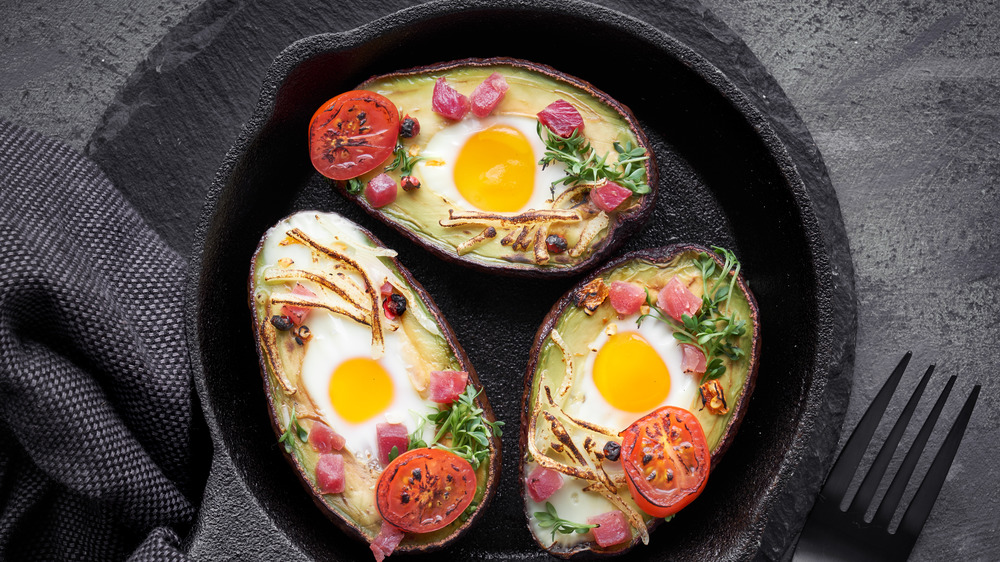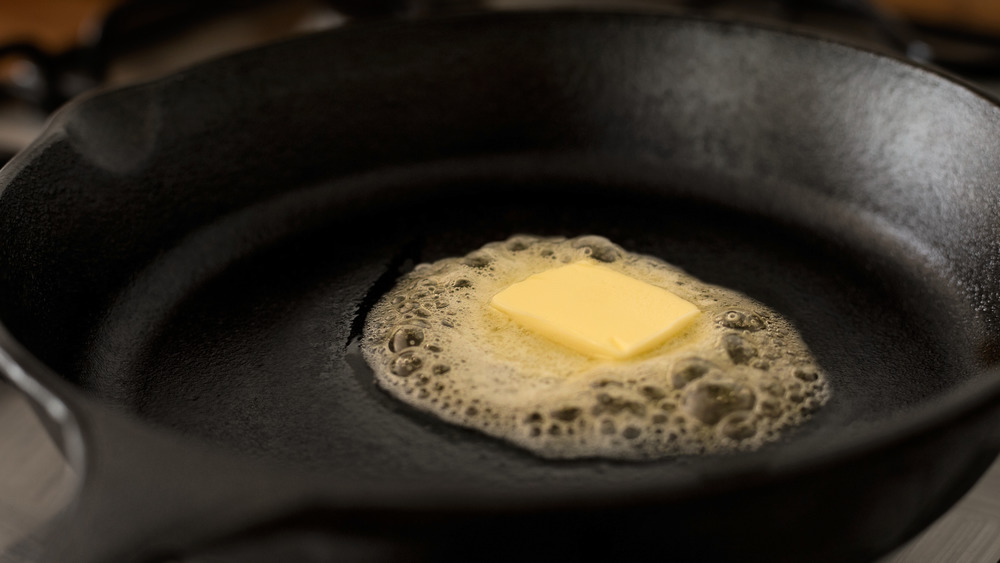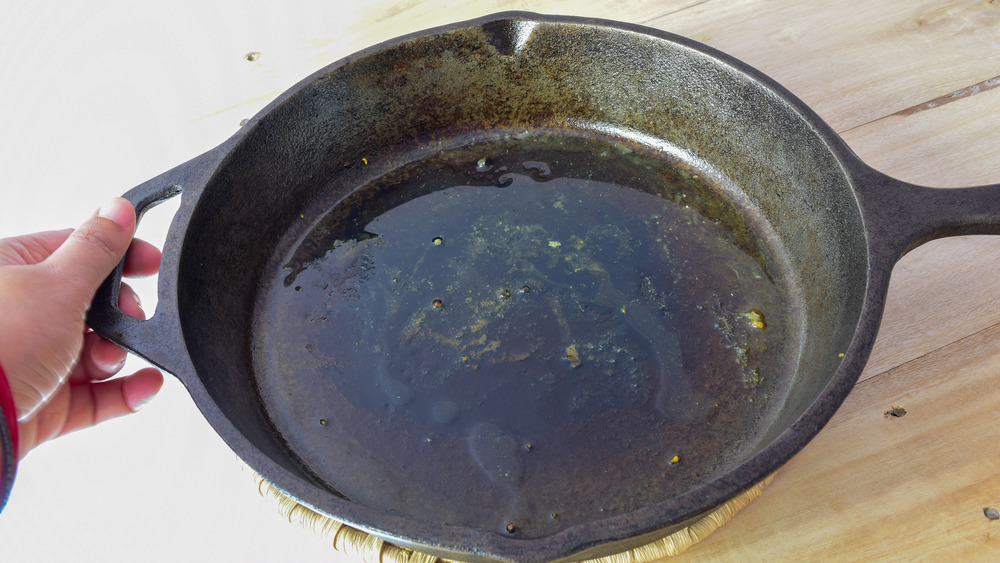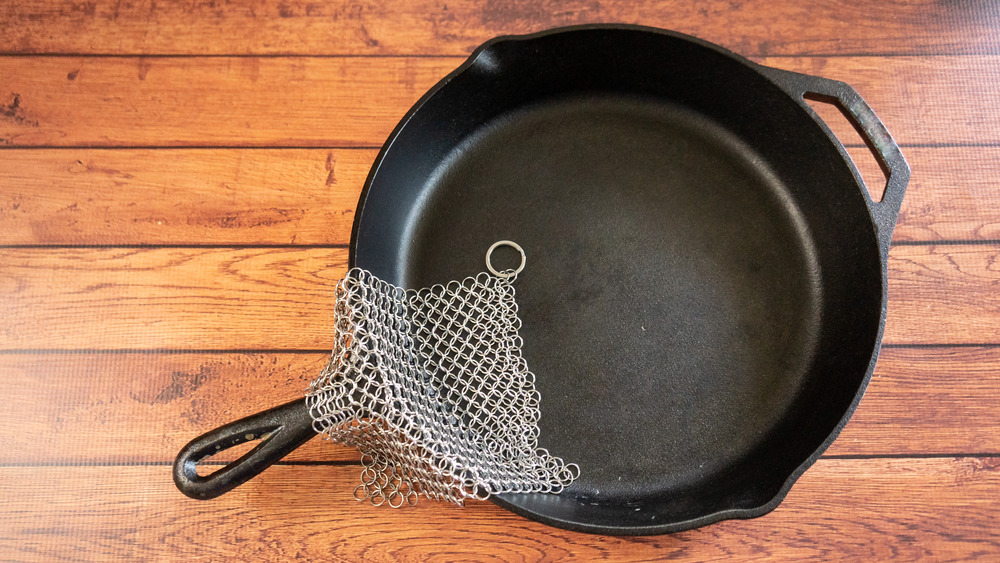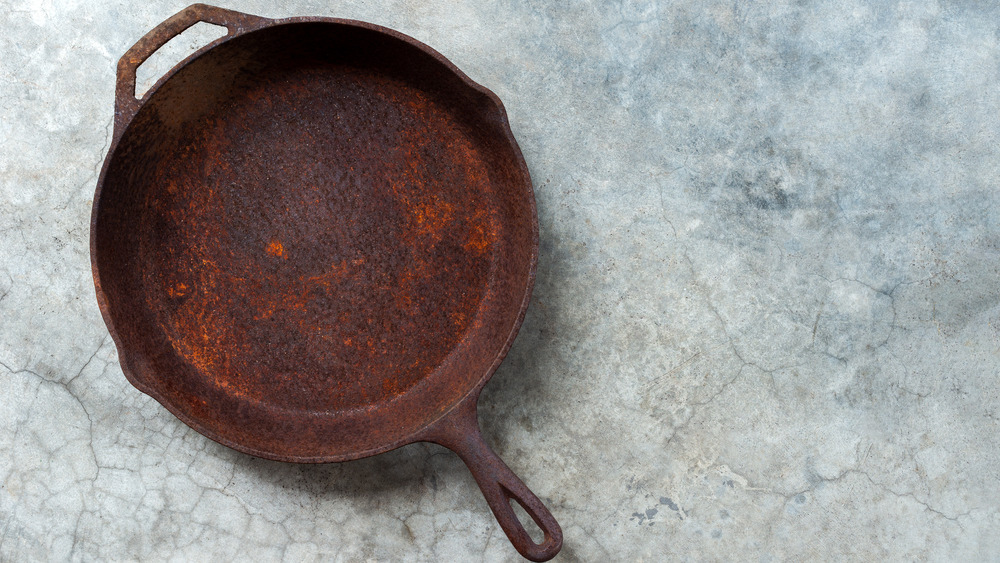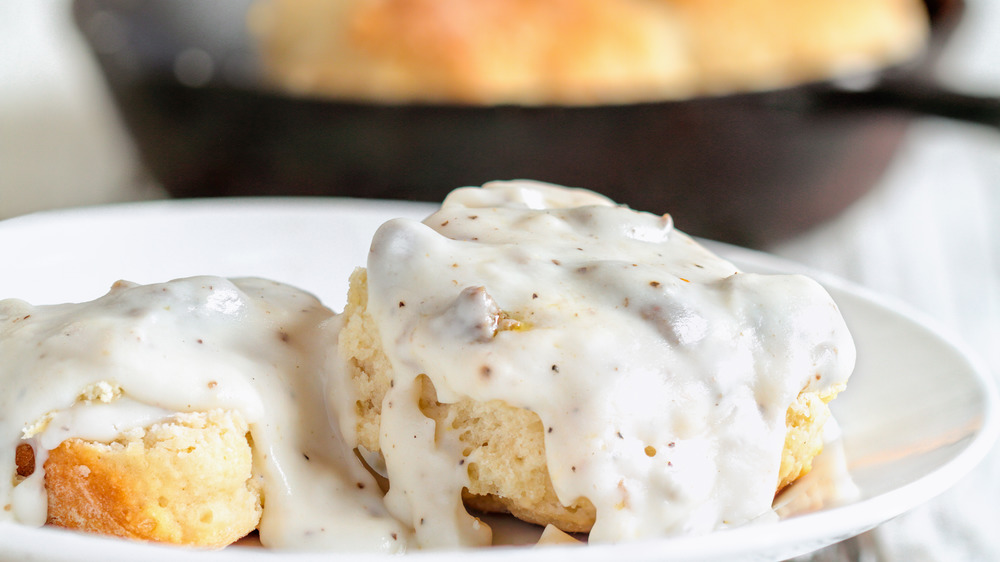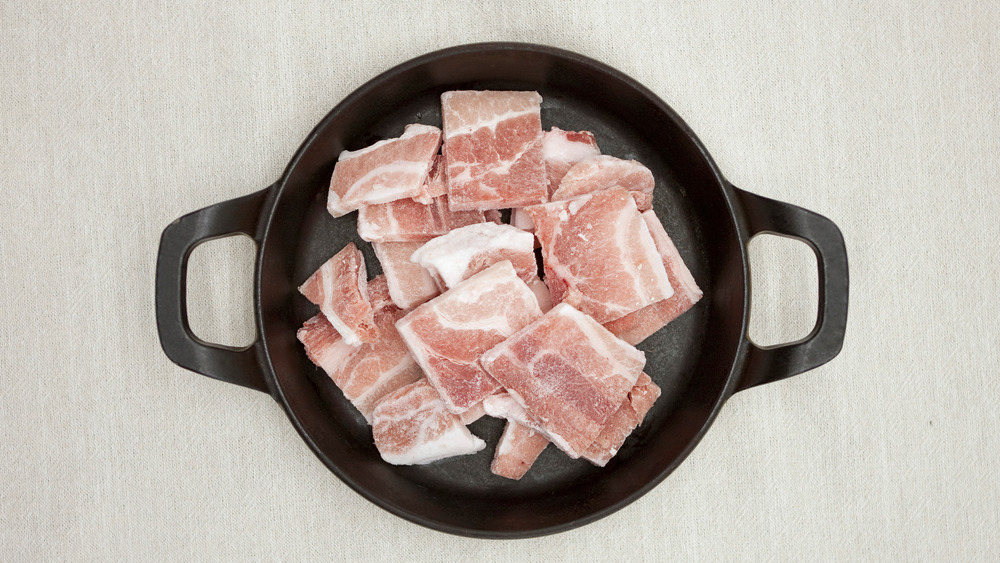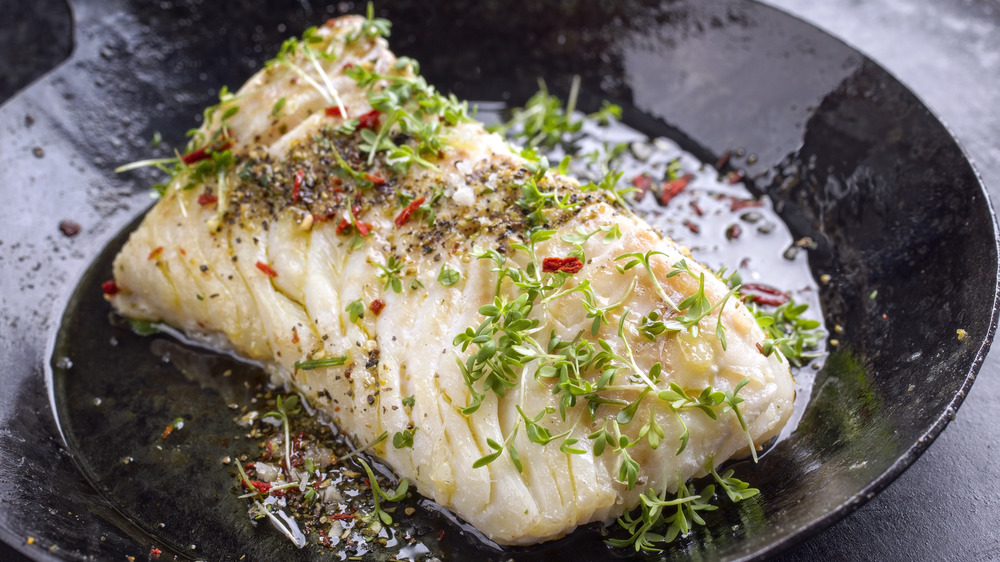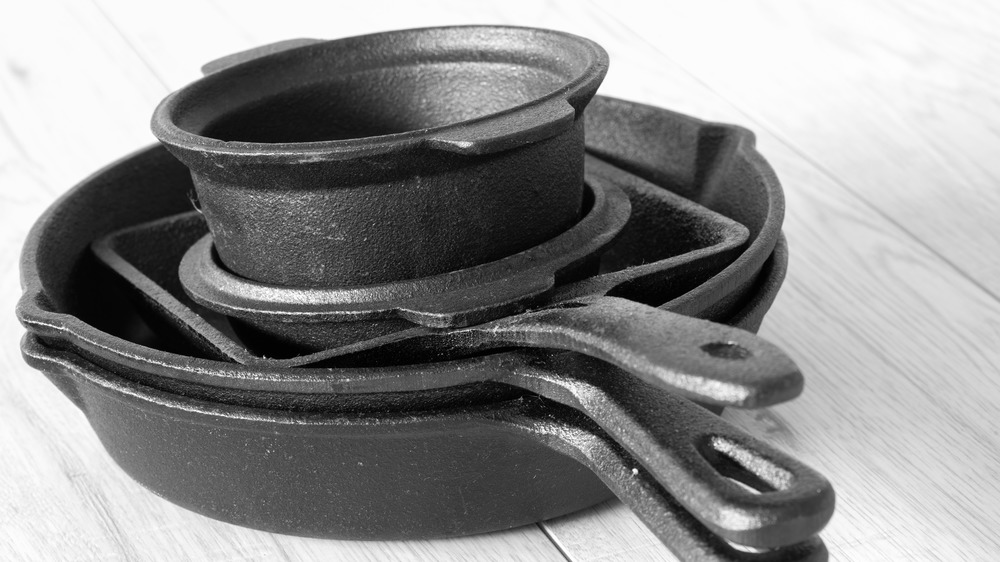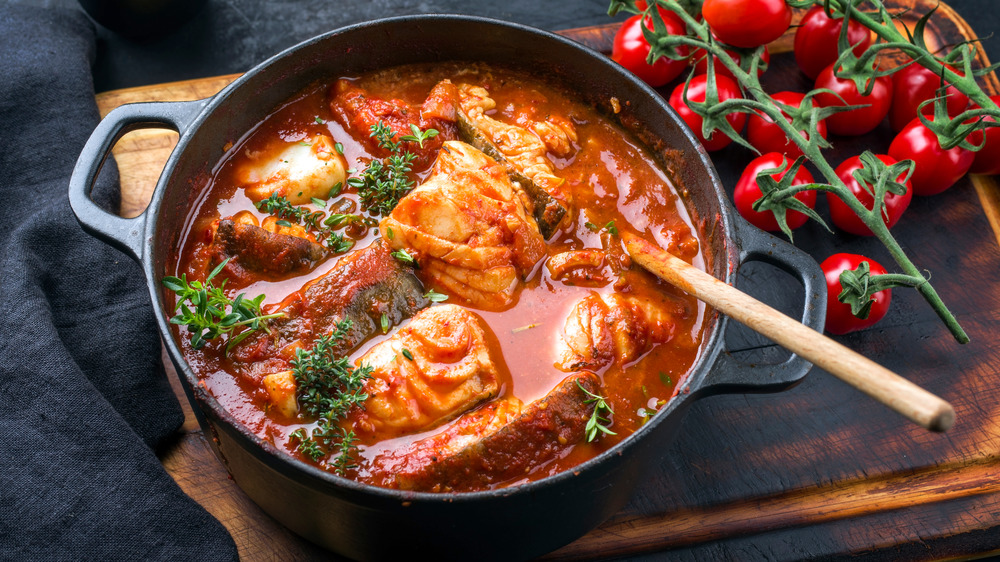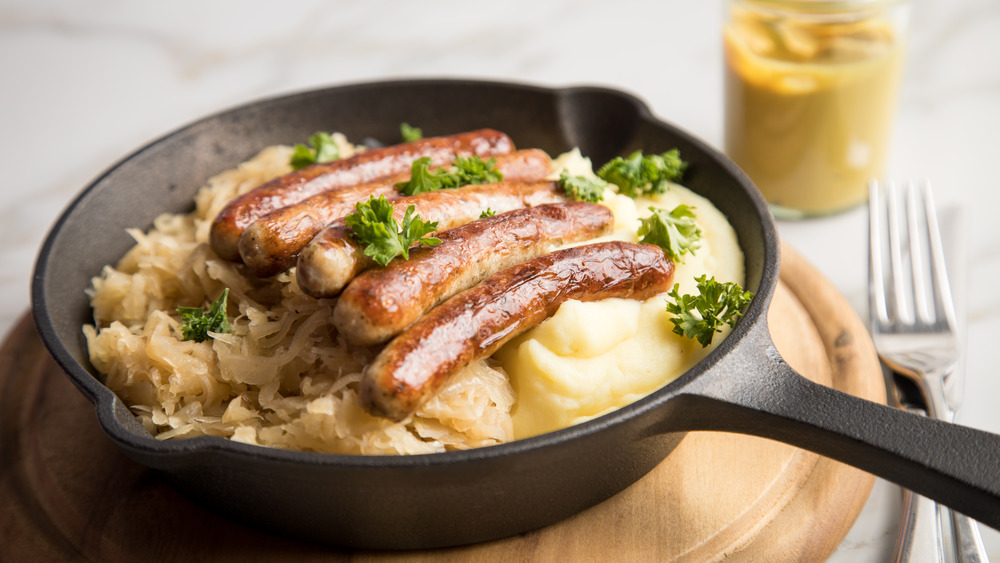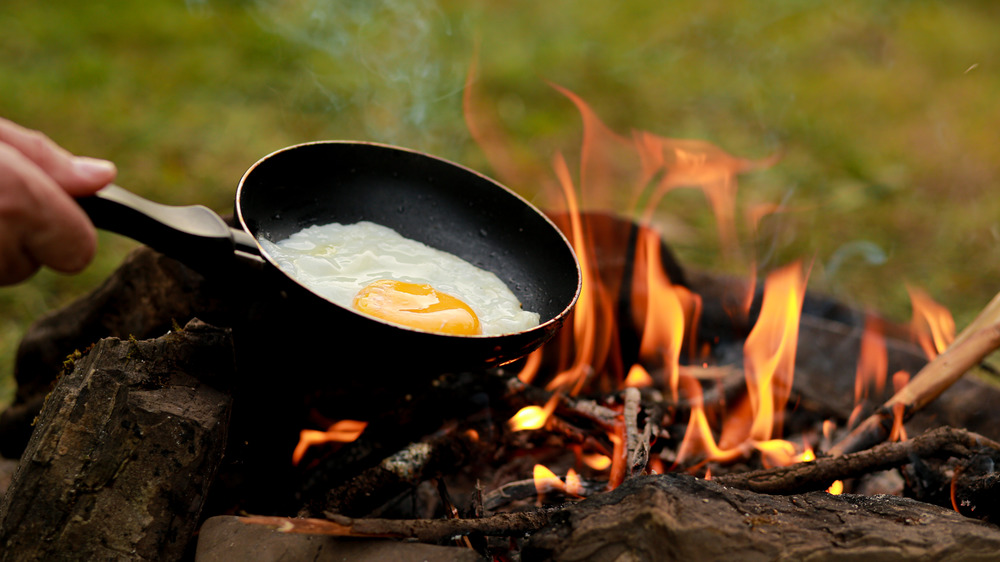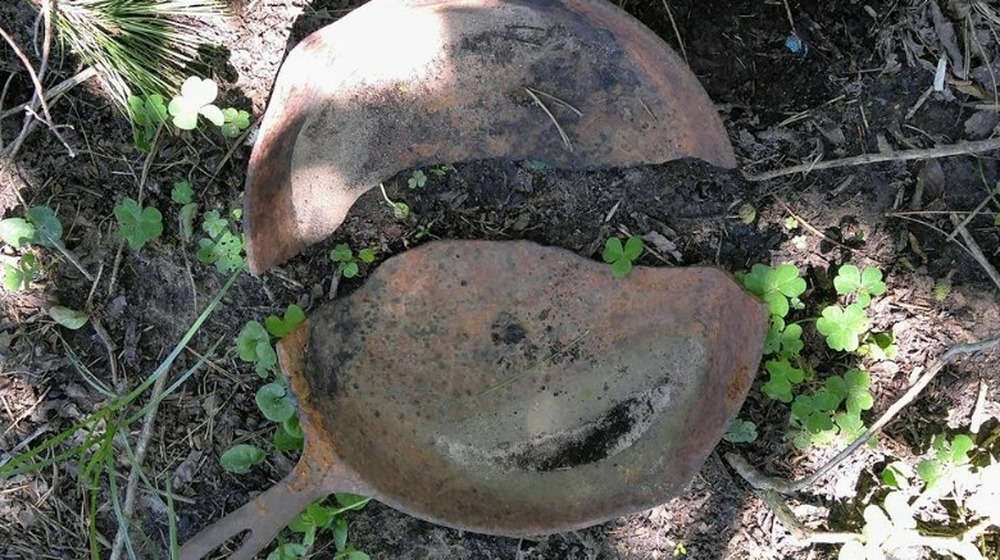Cast Iron Skillet Tips You'll Wish You Knew Sooner
Cast iron skillets are a traditional cooking tool that have been around for a long time. Their cult-like status in the kitchen and longevity means there are a lot of options on how to use and care for a skillet the "right way." Sure, most people know to not cook fish in their cast iron — or at least won't after eating bacon that tastes like a piece of cod — but even for a long-time user, skillet etiquette can be confusing. Should you cook eggs in a cast iron? What does it mean to "season" a skillet properly? Can you really use soap on cast iron? What about preheating a skillet or handling rust? The good news is cast iron isn't as intimidating as it appears. Just don't put cast iron in the dishwasher. Really, just don't.
We have some cast iron skillet tips and straight up hacks for making this classic cooking tool a powerhouse in your kitchen. Once you discover the versatility, durability, and relative ease of a cast iron skillet, you might become a true convert. Just remember not to take your cast iron too seriously. We will explain why some rules matter more than others and how to collect vintage pans if you want. Creativity is encouraged when cooking with a cast iron skillet and with this workhouse, the possibilities are endless.
Preheat your cast iron skillet to make sure food cooks evenly
Cast iron skillets can be intimidating to learn how to use properly. Once the nuances of cast iron are understood, home chefs will be slow to reach for anything else from the cupboard. Slow is coincidentally also the best way to heat a skillet. The Kitchn explains it's not true that cast iron conducts heat well, despite what people might have heard. Instead, the pan's true strength lies in retaining heat. You need to preheat a skillet in order for the pan to absorb heat thoroughly, resulting in foods cooking more evenly.
The Today Show recommends heating a cast iron pan slowly by starting at a low heat and then raising the temperature until it reaches the right level. One tip from the Today Show experts is to position the pan off center and move the pan around the heat source in order to distribute in all areas of the skillet. This can take up to 10 minutes, they say. Why else is this important? The site explains dough might be hard to remove if you place it directly into a cold pan for baking bread in the oven using a skillet. Although preheating might seem like a hassle, this technique is a simple but helpful tip to avoid headaches.
Season your cast iron skillet like a true Southern chef
You've likely heard seasoning a cast iron skillet is important. Seasoning cast iron requires baking oil onto the surface in a process called polymerization, giving the skillet its trademark black surface. Seasoning maintains its non-stick properties and keeps the cast iron from rusting. It's also a rather simple process that'll keep the pan shining bright like a diamond. The good news is there are plenty of tools and tricks to seasoning cast iron. But how're you supposed to know which way is the best?
Serious Eats author Daniel Gritzer is relatable when talking about pouring over cast iron care forums (same), testing flax oil versus Crisco, and fretting over oven temperatures for this "big hunk of iron." Gritzer says the first step is using hot soapy water and then drying for a minute or so over heat to rid the pan of any moisture and grime. Then rub the entire surface (bottom and handle included) with a vegetable, canola, or corn oil until the pan fully absorbs the oil. Next, Serious Eats recommends placing the skillet upside down (to avoid any oil accumulating) in an oven preheated to 450 degrees for 30 minutes. The site recommends removing the hot pan with care and repeating the process of applying oil then baking at least three or four more times. You now have an easy-cook surface and protected cast iron, which only gets better with use.
Don't be afraid to scrub your cast iron clean
Proud owners of a cast iron pan might be hesitant to scrub away all the beautiful seasoning that naturally builds up from use and care. Thankfully, you don't have to be delicate with your trusty skillet. Cast iron skillets benefit from a good scrubbing now and again to remove any stuck-on bits or irregularities in the surface. First We Feast recommends the simple method of heating water in the skillet and then scraping off stubborn food with a scrubber or wood spoon. It's a rather simple way to loosen anything stuck with some elbow grease. The site reports that using kosher salt to scrub the pan and then rinsing the salt off with water also works well.
Ready to up your tool set for scrubbing? The Kitchn recommends using a stiff brush or pan scraper for stuck-on foods without undoing all that time you spent seasoning the pan. The site also recommends a chainmail scrubber that throws out medieval vibes for the modern cook, so whatever works. Combine these two tips to scrub away anything stuck on and don't be afraid to use metal as needed.
Rust can be removed to save a cast iron skillet
If you've ever found a rusty skillet in a thrift store and wondered if it could be revived, this tip is for you. Cast iron skillets are susceptible to rust from humidity, water, improper cleaning, and mistreatment called "profile rusting," says The Kitchn. Even widespread surface rust can be revived with some elbow grease. For deeper rust, the site says you could have the pan sandblasted by a specialist. No, seriously. If you don't have the desire to bust out the sandblaster, you're fortunately in luck.
The New York Times recommends a regular sponge for small patches and a rust eraser made of rubber and silicon carbide for more larger issues. The outlet warns against firm pressure, which could cause "microcracking" that could potentially lead to a broken skillet in the future. For a full-on rust situation, scrub a stainless steel scrubber with some Bar Keeper's Friend and a "couple of tablespoons" of water, the New York Times says. Be careful to protect your hands with gloves when using this combination. The last resort, according to the outlet, is placing the pan in equal parts distilled white vinegar and water for an hour or only as long as necessary for the rust to dissolve.
Use a cast iron skillet to bake in the oven
Relegating a cast iron skillet to only the stovetop is a missed opportunity for many cooks. The fully metal cookware is ideal for using in the oven. Bakers will especially appreciate the crisp edges and "superior" crust on baked goods, according to Fine Cooking. Pie crusts, biscuits, cookies, pancakes, and classic cornbread will all benefit from the browned effect cast irons can deliver. You can even serve directly from the pan, an added bonus when it comes time to clean up. Be sure to skip any stinky or savory foods right before baking anything sweet, or else you might end up with funk from your cast iron.
Similar to cooking on a stovetop, Plant Prosperous recommends preheating the pan by placing it in the oven cold and letting it heat as the oven heats before placing batter or pre-baked goods in the cast iron. She doesn't advise doing this with a pie that needs to be assembled, since the pan would get too hot to touch, so skip this step for your grandma's apple pie. While the skillet warms, use plenty of vegetable oil, coconut oil, lard, or your preferred oil to prevent sticking. A final dusting of flour or cornmeal will prevent your baked good from sticking to the pan. The plant-based chef also prefers to use a 10-inch cast iron skillet for baking because anything bigger than a 12-inch can be heavy when filled with delicious pie.
Thaw frozen foods faster using your cast iron skillet
If you forgot to move dinner items from the freezer to the fridge, you aren't necessarily out of luck. Cast iron skillets can help thaw frozen meat in less time. America's Test Kitchen found placing thin pieces of meat in a skillet for an hour will conduct ambient heat from the iron to the frozen food. The quick version of the defrost is a safe option, says the outlet. Thawing frozen meats at room temperature isn't advised for longer than two hours. The US Department of Agriculture (USDA) recommends thawing in the fridge, cold water, or in the microwave if you're really short on time. An hour might not be quick enough for the hungriest mouths, but it's a helpful hack for cooks who can prep other items until the meat is ready.
Cuisine at Home recommends taking the temperature transfer a step further by wrapping the cast iron pan in plastic wrap first, turning it upside down, and then placing unpackaged frozen items on it. The pan gets colder as the frozen meat, fruit, or veggies thaw, so rotate the frozen food every 15 to 20 minutes, until it's ready to cook. This simple cast iron tip can save time and uses the skillet in an unexpected way.
Remove a stinky smell from a cast iron
Fragrant fish oils can cause problems with subsequent meals prepared in a cast iron skillet. No one wants to taste fish on their chocolate chip cookies or morning bacon (guilty of this one!). Deodorizing a cast iron doesn't have to be messy or smelly. Cooks Illustrated tested multiple skillets to remove smelly fish oils without stripping the seasoning. They found cooking the pan with a bit of oil until it reaches a smoking point can remove the smell, but it left a mess of oil behind. Now we're asking, is the oil even necessary?
Baking the cast iron in the oven isn't just for seasoning. Cook's Illustrated reports compounds called trialkylamines that cause the distinct fish smell will burn off between 200 and 250 degrees. When a pan reaches 350 degrees, the site found even the "oxidized fatty acids" are removed. So, no messy oil to clean out of the pan and no pungent, smoke-filled kitchen when compared to stovetop methods. Bake the fishy skillet for a mere 10 minutes at 400 degrees and it will take care of the stink without any left over oil, the site says. Simple enough right?
Buy vintage cast irons for unique and cost-effective styles
If taken care of correctly, a cast iron skillet can last generations. While some newcomers might be hesitant at first to invest in a vintage cast iron, buying vintage can be cost effective and relatively painless. The Kitchn reports a dealer might locate a vintage cast iron in decent condition for prices starting around $75. The site says any pan made before 1957 is considered vintage, and name brand cookware from the 1800s to the 1900s is also available. Rust isn't a deal breaker when it comes to buying vintage, since it can be removed.
The cooking outlet does warn serious rust can hide major flaws in the pan such as warping, cracks, or pitting. The Kitchn also reports "crusted-over old relics" could be found at a yard sale or a flea market that would fit the bill when you know what to look out for. Just push on the edge to see if the pan wobbles when on a flat surface and knock on the bottom of the skillet to ensure it rings like a bell, the outlet says. Reuse saves perfectly good cast irons, and potentially saves some money when compared to buying a new skillet. Plus, you might find a real cute and collectable vintage cast iron.
Is it worth cooking acidic foods in your cast iron?
It's a myth that acidic foods such as tomatoes, white wine sauces, and lemon juice will ruin your pan — as long as it's seasoned correctly. What is more likely is that slow-cooked white wine and Bolognese and other acidic sauces will come out tasting metallic. Gross and unnecessary. America's Test Kitchen experimented with an acidic tomato sauce and found the flavor changed after simmering for a full 30 minutes. While this flavor change isn't ideal, a quick sauté won't hurt the pan. Seasoned pans are protected from acidity, but after a certain point, bits of the metal will leech from the skillet, which is why the food could taste metallic. But, the test kitchen advises to add acidic ingredients last and use shorter cook times to avoid any pH changes.
Serious Eats reports that even a well-seasoned pan might have some bare sections that could interact with acidic foods. Cast iron is meant to be used and cooks aren't expected to be perfect. The site admits small amounts of acidic ingredients, such as deglazing a pan with wine, won't cause any issues. While acid might not be as harmful as the myth would have us believe, it would be a shame to toss out a good meal because it tastes like metal. It's really up to you if you want to grab another pan for your classic Bolognese sauce (we won't judge).
Double up with a cast iron skillet to warm up delicate dishes
Keeping food warm on the stove or warming delicate ingredients can be tricky, especially if you're multi-tasking. A cast iron can act like a layer of protection and can retain heat when in the kitchen. Worried you're going to burn the delicate preparations? America's Test Kitchen found cast iron reduces high heat when placed under another pot melting butter. The butter won't overheat and brown. The site also recommended using the heavy duty pan on the stove to keep food like mashed potatoes warm without getting a burnt crust on the bottom (not that we would know anything about that!).
Keep in mind that an actual double boil technique uses two pots to slowly melt delicate foods like chocolate. The bottom pot is full of water to help regulate a gentle heat. Water is the mortal enemy of a cast iron (a bit dramatic, but you get the idea), so it might be best to leave that style of doubling up to its stainless steel cousins. Leaving a cast iron soaking in water in it for too long is a big risk for rust.
Overheating your cast iron is a great way to ruin it
Overheating a cast iron pan is easier than you think. Too much heat on a cast iron skillet can be as simple as burning food (still a bummer) or can have consequences that are more serious. Thanks to cast iron retaining heat so well, Taste of Home warns the pan can overheat quicker than other cookware. If a pan is smoking, the cooking outlet says, then the skillet is way too hot. The site recommends taking the pan off of the heat and letting it cool down before you continue.
Home cooks can easily overheat a pan by accident whether at home or while camping. Cooking on an open fire requires a bit of nuance to not overheat and ruin a perfectly good skillet. Outdoor lovers should not to get too eager by placing a skillet directly over the hot flames of a campfire or risk burning the pan. Instead, place it on coals, which will also result in a more even heat.
HuffPost also found sudden temperature changes, such as washing a hot pan with cold water, could cause a pan to warp. While this workhorse is designed to retain heat, fast temperature changes can cause "thermal shock," leading to uneven cooking and warping. Avoid placing a hot pan under running water, and instead wait until it reaches room temperature. A little patience can help keep a cast iron skillet working for the long run.
Know when the cast iron is beyond repair
Cast iron skillets are built to last and often only get better with age. The care and longevity are a couple of the reasons professional and home cooks have built a cult following around this kitchen cookware staple. Despite this, every cook with a cast iron needs to know when a pan is beyond repair. Despite rumors to the uninitiated, cooks are likely to agree a cast iron skillet is not indestructible. Don't be fooled.
The Kitchn explains a crack, warping, or a hole in the pan are points of no return. A crack in a pan is similar to one in a nice wine glass. The fracture might seem harmless, but it will only grow and act as a ticking time bomb. A hole is the sign of either rust beyond repair or is a warning sign that an older piece might have been used for something more hazardous than cooking, the site says. A warped pan is another liability for being unstable and cooking food unevenly — a reason to move on to fresher iron. We also heartily agree that if a cast iron skillet is just taking up cupboard space and not being used, gift or donate the pan to someone who will use it.
